
| Version | Summary | Created by | Modification | Content Size | Created at | Operation |
|---|---|---|---|---|---|---|
| 1 | Dr. Mizanur Rahman | + 2797 word(s) | 2797 | 2022-01-04 10:38:19 | | | |
| 2 | Lindsay Dong | + 28 word(s) | 2825 | 2022-01-05 03:56:48 | | |
Video Upload Options
Nitrogen (N) fertilizer use is the largest in the crop sector, an important sector, where current annual consumption is 1190 Gg. The present combined annual Nr production from crop, fishery, and livestock sectors is ~600 Gg, while emissions of nitrous oxide (N2O), a potent greenhouse gas, are ~200 Gg. Poor N management results in Nr leaking into the environment, which has increased approximately 16-fold since 1961. One potential consequence is the disruption of ecosystem functioning. The balanced tradeoff between food production and reducing Nr input needs to be achieved. One solution to reducing unutilized reactive N (Nr) may be a holistic approach that optimizes N application rates and incorporates waste of one subsector as an input to another applying the principle of the circular economy.
1. Introduction
2. Reactive Nitrogen Flows in Bangladesh’s Agriculture Sector
2.1. Nitrogen Fertilizer Consumption, Production, and Import in Bangladesh
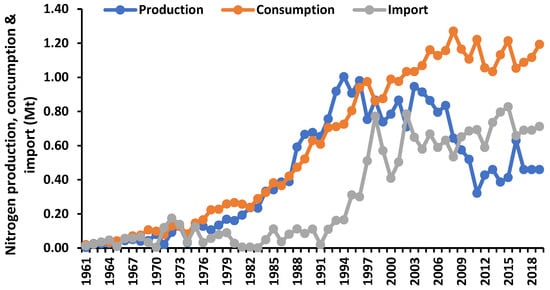
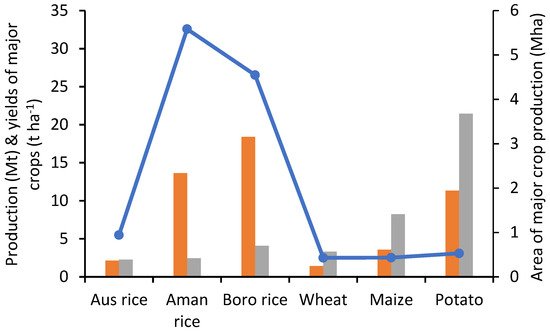
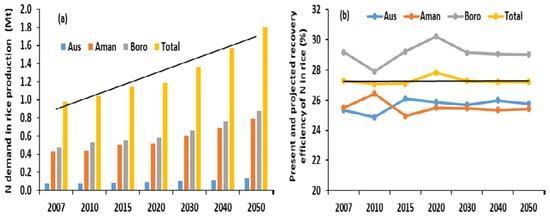
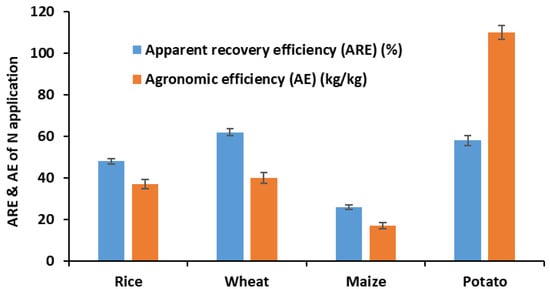
2.2. Reactive N (Nr) Production in Bangladesh’s Agriculture
Significant proportions of N fertilizer applied for crop production are subject to loss to the atmosphere. The release of Nr from N fertilizer as NH3, N2O, and NO in Bangladesh since 1961 to 2019 has increased dramatically (Figure 5a). From 1961 to 2019, emissions of NH3, N2O, and NO from N fertilizer increased from 4.72 to 263.45, 0.68 to 37.95, and from 0.28 to 15.65 Gg, respectively. This magnitude of loss of Nr from inorganic N fertilizer is of serious concern for agricultural and environmental sustainability. Production of Nr and its losses to the environment have increased in recent years mostly because of higher rates of N fertilizer application coupled with low use efficiency.

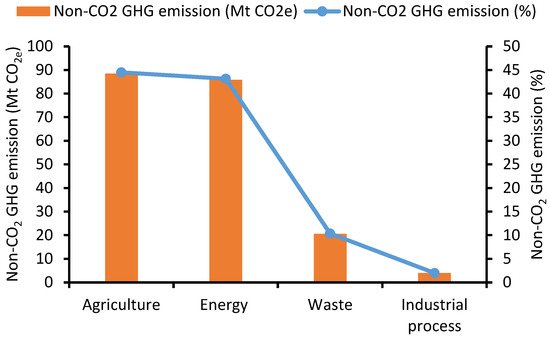
2.3. Nitrogen Use and Nr Production in Aquaculture
Fish provide 60% of the animal protein to the people of Bangladesh [40]. During the recent decades, aquaculture ventures have increased and intensified. The shift from low-input, extensive systems to high-input, intensive aquaculture systems has resulted in a huge demand for fish feed. Total feed production for pond aquaculture in 2008 was only 0.67 Mt, which increased 400 times to 2.66 Mt in 2017 (Figure 7a). Total feed comprises sinking, floating, and farm-made feeds, which contributed a total of 37,520 t of N in 2008, increasing to 148,960 t in 2017. Mamun-Ur-Rashid et al. [41] reported that the production and sale of fish feed in Bangladesh’s aquaculture have increased radically in the last decade, where about 1.04 Mt of feed was produced commercially and between 0.3 and 0.4 Mt was produced at th village level with additional imports needed. Actual feed requirements are higher than local production. Raw unformulated feeds such as rice bran and mustard oil cake are applied to fishponds. Farmers in Bangladesh apply 1000 t of raw and unprocessed feed in their ponds annually [42]. This is included in farm-made feed in Figure 7a. Mamun-Ur-Rashid et al. [41] also reported that, since 2008, feed production has increased by 32% annually to approximately 3.0 Mt in 2017. Other data led to a fish feed requirement estimation of 2.65 Mt in 2017 in Bangladesh [43]. Fish feed serves as an important input of Nr in the aquaculture sector of the country, and cultured fish ponds released 675 t of N2O in 2008 and 2681 tons in 2017 (Figure 7b). Total ammonia (NH4+ and NH3) production in fish ponds was 21,574 and 85,652 t in 2008 and 2017, respectively (Figure 7b). Unaccounted-for loss of N was calculated to be 4014 t in 2008 and 20,587 t in 2017.
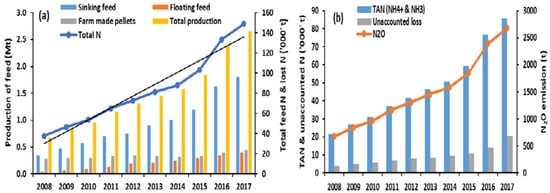
2.4. Manure N and Nr Production from Livestock and Poultry
| Livestock Resources | Year | Growth Rate (%) | |||||||
|---|---|---|---|---|---|---|---|---|---|
| 1949 | 1960 | 1977 | 1984 | 1996 | 2008 | 2011 | 2017 | ||
| Bovine (cattle, buffaloes, horses) | 16.37 | 21.105 | 20.58 | 22.06 | 22.29 | 26.22 | 25.80 | 25.40 | 0.53 |
| Sheep, goats | 4.27 | 6.14 | 9.155 | 14.22 | 14.61 | 17.62 | 17.32 | 29.33 | 2.31 |
| Poultry (fowls and ducks) | 25.22 | 20.10 | 47.52 | 73.71 | 126.67 | 137.24 | 135.10 | 329.20 | 2.39 |
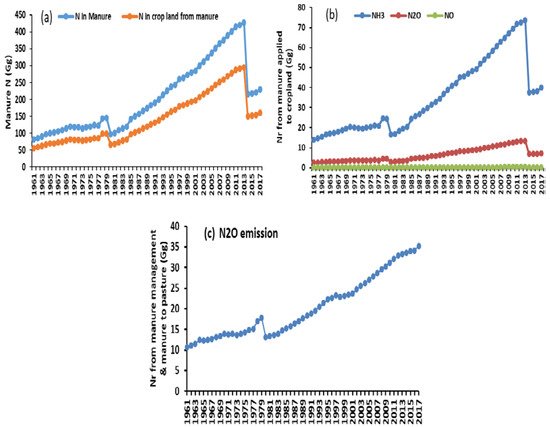
References
- Sutton, M.A.; Howard, C.M.; Erisman, J.W.; Billen, G.; Bleeker, A. The European Nitrogen Assessment: Sources, Effects and Policy Perspectives; Cambridge University Press: Cambridge, UK, 2011.
- Erisman, J.W.; Galloway, J.N.; Seitzinger, S.; Bleeker, A.; Butterbach-Bahl, K. Reactive nitrogen in the environment and its effect on climate change. Curr. Opin. Environ. Sustain. 2011, 3, 281–290.
- Erisman, J.W.; Sutton, M.A. Reduced nitrogen in ecology and the environment: Special issue of the ESF-FWF Conference in partnership with LFUI, October 2006. Environ. Pollut. 2008, 154, 357–507.
- UNEP. Frontiers 2018/19 Emerging Issues of Environmental Concern; United Nations Environment Programme: Nairobi, Kenya, 2019.
- Ju, X.T.; Xing, G.X.; Chen, X.P.; Zhang, S.L.; Zhang, L.J.; Liu, X.J.; Cui, Z.L.; Yin, B.; Christie, P.; Zhu, Z.L.; et al. Reducing environmental risk by improving N management in intensive Chinese agricultural systems. Proc. Natl. Acad. Sci. USA 2009, 106, 3041–3046.
- Sutton, M.A.; Oenema, O.; Erisman, J.W.; Leip, A.; van Grinsven, H.; Winiwarter, W. Too much of a good thing. Nature 2011, 472, 159–161.
- Lu, C.; Tian, H. Net greenhouse gas balance in response to nitrogen enrichment: Perspectives from a coupled biogeochemical model. Glob. Chang. Biol. 2013, 19, 571–588.
- UNEP; WHRC. Reactive Nitrogen in the Environment: Too Much or too Little of a Good Thing; United Nations Environment Programme: Paris, France, 2007.
- O’Neill, A. Share of Economic Sectors in the GDP in Bangladesh 2020. Available online: https://www.statista.com/statistics/438359/share-of-economic-sectors-in-the-gdp-in-bangladesh/ (accessed on 27 July 2021).
- AIS. Agriculture Information Services; Krishi Diary 2018; Department of Agriculture Extension, Ministry of Agriculture, Government of Bangladesh: Dhaka, Bangladesh, 2018.
- Sikder, R.; Xiaoying, J. Climate change impact and agriculture of Bangladesh. J. Environ. Earth Sci. 2014, 4, 35–40.
- Islam, M.R.; Hasan, M.Z. Losses of agricultural land due to its infrastructural development: A study on Rajshahi district. Int. J. Sci. Eng. Res. 2013, 4, 391–397.
- World Population Review. 2008. Available online: http://worldpopulationreview.com/countries/bangladesh-population/ (accessed on 16 April 2018).
- FAO. Fishery and Aquaculture Country Profiles, The People’s Republic of Bangladesh; FAO Fishery and Aquaculture Department, Food and Agriculture Organization of the United Nations: Rome, Italy, 2014; Available online: http://www.fao.org/fishery/facp/BGD/en (accessed on 27 July 2021).
- FRSS. Yearbook of Fisheries Statistics of Bangladesh; Fisheries Resources Survey System (FRSS), Department of Fisheries, Bangladesh: Dhaka, Bangladesh, 2016; Volume 32, pp. 1–57.
- DoF. Fisheries Statistical Yearbook of Bangladesh 2012–2013; Fisheries Resource Survey System (FRSS), Department of Fisheries: Dhaka, Bangladesh, 2014; p. 52.
- Hu, Z.; Lee, J.W.; Chandran, K.; Kim, S.; Khanal, S.K. Nitrous oxide (N2O) emission from aquaculture: A review. Environ. Sci. Technol. 2012, 46, 6470–6480.
- BES. Bangladesh Economic Survey; Department of Finance, Ministry of Finance and Planning, Government of the People’s Republic of Bangladesh: Dhaka, Bangladesh, 2009; p. 71.
- DLS. Annual Report on Livestock; Division of Livestock Statistics, Ministry of Fisheries and Livestock: Dhaka, Bangladesh, 2013.
- FRG. Fertilizer Recommendation Guide (FRG); Bangladesh Agricultural Research Council (BARC): Dhaka, Bangladesh, 2018; p. 223.
- ILMM. Draft National Integrated Livestock Manure Management (ILMM) Policy; Government of the People’s Republic of Bangladesh Ministry of Fisheries and Livestock, Bangladesh Secretariat: Dhaka, Bangladesh, 2015.
- Zhang, X.; Fang, Q.; Zhang, T.; Ma, W.; Velthof, G.L.; Hou, Y.; Oenema, O.; Zhang, F. Benefits and trade-offs of replacing synthetic fertilizers by animal manures in crop production in China: A meta-analysis. Glob. Chang. Biol. 2020, 26, 888–900.
- Singh, B.; Ryan, J. Managing Fertilizers to Enhance Soil Health; International Fertilizer Industry Association: Paris, France, 2015.
- Sutton, M.A.; Howard, C.M.; Adhya, T.K.; Baker, E.; Baron, J.; Basir, A.; Brownlie, W.; de Vries, W.; Eory, V.; Hicks, K.W.; et al. Nitrogen—Grasping the Challenge. A Manifesto for Science-in-Action through the International Nitrogen Management System; Centre for Ecology & Hydrology: Edinburgh, UK, 2019.
- Islam, S.M.; Yam, K.G.; Shah, A.L.; Singh, U.; Sarkar, M.I.U.; Satter, M.A.; Sanabria, J.; Biswas, J.C. Rice yields and nitrogen use efficiency with different fertilizers and water management under intensive lowland rice cropping systems in Bangladesh. Nutr. Cycl. Agroecosyst. 2016, 106, 143–156.
- Bodisrsky, B.L.; Popp, A.; Lotze-Campen, H.; Dietrich, J.P.; Rolinski, S.; Weindl, I.; Schmitz, C.; Muller, C.; Bonsch, M.; Humpenöder, F.; et al. Reactive nitrogen requirements to feed the world in 2050 and potential to mitigate nitrogen pollution. Nat. Commun. 2014, 5, 3858.
- Lu, C.; Tian, H. Global nitrogen and phosphorus fertilizer use for agriculture production in the past half century: Shifted hot spots and nutrient imbalance. Earth Syst. Sci. Data 2017, 9, 181–192.
- FAOSTAT. Agriculture Statistics from 1961–2017 FAODATA Statistics. 2019. Available online: http://www.fao.org/faostat/en/#data (accessed on 15 March 2019).
- BBS. Statistical Year Book of Bangladesh; Statistics Division, Bangladesh Bureau of Statistics, Ministry of Planning, The Government of Peoples Republic of Bangladesh: Dhaka, Bangladesh, 2018.
- IFASTAT. International Fertilizer Association. 2019. Available online: https://www.ifastat.org/databases/plant-nutrition (accessed on 12 February 2019).
- Bangladesh Unnayan Onneshan. Future Fertilizer Demand for Sustaining Rice Production in Bangladesh: A Quantitative Analysis. Unnayan Onneshan-The Innovators 16/2, Indira Road, Farmgate, Dhaka-1215, Bangladesh. 2018. Available online: http://www.unnayan.org/reports/Livelihood/future_fertilizer_demand.pdf (accessed on 15 April 2018).
- FAO. World Fertilizer Trends and Outlook to 2018; Food and Agriculture Organization of the United Nations: Rome, Italy, 2015.
- Alam, M.A.; Rahman, M.M.; Biswas, J.C.; Akhter, S.; Maniruzzaman, M.; Choudhury, A.K.; Jahan, A.B.M.S.; Miah, M.M.U.; Sen, R.; Kamal, M.Z.U.; et al. Nitrogen transformation and carbon sequestration in wetland paddy field of Bangladesh. Paddy Water Environ. 2019, 17, 677–688.
- Weil, R.R.; Brady, N.C. The Natures and Properties of Soils, 15th ed.; Pearson: New York, NY, USA, 2016; p. 1104.
- Islam, M.S. Soil Management in Agricultural Research in Bangladesh; Bangladesh Agricultural Research Council: Dhaka, Bangladesh, 1983; pp. 105–109.
- Wortmann, C.S.; Tarkalson, D.D.; Shapiro, C.A.; Dobermann, A.R.; Ferguson, R.B.; Hergert, G.W.; Walters, D. Nitrogen use efficiency of irrigated corn for three cropping systems in Nebraska. Agron. J. 2011, 103, 76–84.
- AIS. Agriculture Information Services; Department of Agriculture Extension, Ministry of Agriculture, Government of Bangladesh: Dhaka, Bangladesh, 2016.
- BBS. Statistical Year Book of Bangladesh; Statistics Division, Bangladesh Bureau of Statistics, Ministry of Planning, The Government of Peoples Republic of Bangladesh: Dhaka, Bangladesh, 2016.
- Climatewatch. Historical GHG Emission. Available online: https://www.climatewatchdata.org/ghg-emissions?end_year=2018&start_year=1990 (accessed on 12 May 2021).
- DoF. Fisheries Statistical Yearbook of Bangladesh, 2017–2018; Fisheries Resources Survey System (FRSS), Department of Fisheries, Ministry of Fisheries: Dhaka, Bangladesh, 2018; Volume 35, p. 129.
- Mamun-Ur-Rashid, M.; Belton, B.; Phillips, M.; Rosentrater, K.A. Improving Aquaculture Feed in Bangladesh: From Feed Ingredients to Farmer Profit to Safe Consumption; World Fish: Penang, Malaysia, 2013; pp. 2013–2034.
- Barman, B.K.; Karim, M. Analysis of feeds and fertilizers for sustainable aquaculture development in Bangladesh. In Study and Analysis of Feeds and Fertilizers for Sustainable Aquaculture Development; Hasan, M.R., Hecht, T., de Silva, S.S., Tacon, A.G.J., Eds.; FAO Fisheries Technical Paper. No. 497; FAO: Rome, Italy, 2007; pp. 113–140.
- Hossain, T. Grain and Feed Annual: Bangladesh; Gain Report, BG 1803; Global Agricultural Information Network, USDA Foreign Agricultural Services: Washington, DC, USA, 2018.
- Rahman, M.M.; Yakupitiyage, A.; Ranamukhaarchchi, S.L. Agricultural use of fish pond sediment for environmental amelioration. Thammassat Int. J. Sci. Technol. 2004, 9, 1–10.
- BBS. Statistical Year Book of Bangladesh; Statistics Division, Bangladesh Bureau of Statistics, Ministry of Planning, The Government of Peoples Republic of Bangladesh: Dhaka, Bangladesh, 2012.
- Galloway, J.N.; Cowling, E.B. Reactive nitrogen and the world: 200 years of change. AMBIO J. Hum. Environ. 2002, 31, 64–71.
- Erisman, J.W.; Galloway, J.N.; Dies NBSutton, M.A.; Bleeker, A.; Grizzetti, B.; Leach, A.M.; de Vries, W. Nitrogen: Too Much of a Vital Resource; Science Brief; WWF: Zeist, The Netherlands, 2015.




